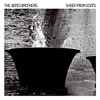The Noyes Brothers, "Sheep From Goats"
 Another chapter in LTM's Boutique Label reissue campaign of obscure Manchester post-punk label Object Music, this collection presents more than 100 minutes of experiments, improvisations, skewed pop, drone-laden blues, minimal electronic synthpop and weird, dislocated Nurse With Wound-style audio surrealism. A reissue of a double-album originally issued in 1980—a collaborative release by labelmates Steve Solamar (Spherical Objects) and Steve Miro—Sheep From Goats was certainly the most adventurous release by Object Music during its brief existence.
Another chapter in LTM's Boutique Label reissue campaign of obscure Manchester post-punk label Object Music, this collection presents more than 100 minutes of experiments, improvisations, skewed pop, drone-laden blues, minimal electronic synthpop and weird, dislocated Nurse With Wound-style audio surrealism. A reissue of a double-album originally issued in 1980—a collaborative release by labelmates Steve Solamar (Spherical Objects) and Steve Miro—Sheep From Goats was certainly the most adventurous release by Object Music during its brief existence.
Elsewhere in these pages (here and here), I have addressed the bundle of contradictions embodied by Object Music founder and Spherical Objects frontman Steve Solamar, who ceased label operations in 1981 to undergo his own radical operation, resolving his inner contradictions by becoming a woman. At the time of the sessions which eventually became Sheep From Goats, Solamar's contradictions were in full flower. From the name of the project down to the absurdist, eclectic content of the album, paradox seems to have been the key artistic strategy at work here. Steve Miro chose the name The Noise Brothers, but Solamar made a point of changing the spelling of "noise" to "no/yes," in order to carry through the concept of inner contradiction. The album's recording process was somewhat unique as well, with the two Steves meeting for recording sessions over a period of months, a collaboration which produced sides one and four of the double LP. Then, the two each recorded six songs separately, which were distributed over sides two and three. This process results in an album of largely electronic, often improvised music which uses dissonance, incongruity and divergency to its advantage.
The music made by the Steves doesn't much resemble the solo work of Miro or the work of Solamar's Spherical Objects. Although there are a few moments in which he channels the same cryptic blues that he later revisited on the final SO album No Man's Land, most of Solamar's contributions are utterly dislocated and strange, wobbly synthesizer excursions that launch the gray, industrial atmospherics of Thatcherite Manchester into the outer reaches of space. By contrast, Miro recruits his wife Jill/Jae Boyer to sing on three of his tracks, delivering a suite of melancholic, psychedelic pop songs that must have sounded terribly unfashionable at the time of the album's release. Both Brothers' solo contributions are notable in their own way but without question the centerpiece of the album is the sidelong "It Seemed Like A Good Idea At The Time," which in some parallel universe is considered a seminal milestone of electronic music. In our universe, it is rarely considered at all, a 25-minute dirge through a burning brain, all chugging primitive drum machines and art-damaged synth drone, keyboard noodling and mostly wordless vocal improvisations by Solamar. If Steven Stapleton had decided to form a coldwave synthpop band instead of Nurse With Wound, this would have been Side A of the debut album. The closest analog I can think of for this utterly bizarre moment in post-punk history would be John Bender's incredibly obscure Pop Surgery LP, though even this comparison fails to capture the idiosyncrasies at work in The Noyes Brothers.
Boutique's reissue juggles the original tracklisting somewhat, which has the effect of making the album seem even more disorienting, as "It Seemed Like A Good Idea" comes halfway through the listening experience, rather than at the end. This decision was probably made out of pragmatics more than anything else but I appreciate the way in which it augments the album's eclecticism. Listening to Sheep From Goats multiple times, what begins to stand out are not isolated moments or individual tracks, but rather the combined effect of the album's dynamic and scattershot approach. Had the album contained only Solamar's improvised electronic excursions and "Good Idea," it might be easily pidgeonholed as another example (albeit a good one) of early 1980s proto-industrial coldwave, alongside acts like Portion Control, Fad Gadget or Absolute Body Control. However, any album which contains ingenious psych-pop nuggets like Miro's "It Must Be Vibration" alongside Solamar's mind-zapping guitar effects phantasmagoria on "Decision Time" demands to be liberated from the usual genrification schemes applied to musical movements of the past.
Although I do have a certain affection for Miro and Solamar's individual takes on bluesy post-punk, I think Sheep From Goats is at its best when the Steves stop adhering to any kind of song structure. Standout tracks include Solamar's "Pneumonia Bridge," an aquatic sound collage that transforms whalesong into the screams of seagulls, envisaging jaw harp twangs through the disorienting vision doubling of intoxication. One of the best collaborative tracks, "Bo Scat Um I.D." uses the basic building blocks of the new wave—melodic, minor-key basslines, drums, chiming guitars, oppressive synths—but disassembles them, putting them back in an order that no longer makes sense, adding Solamar's incongruous blues harp and throaty, asexual vocal yelps and moans. "Byte To Beat" is a dislocated, claustrophobic samba from another dimension, marrying the UFOs-on-heroin aesthetics of the Liquid Sky soundtrack to the logic of punk in the wake of Throbbing Gristle and Industrial Records.
Boutique's reissue tacks the lengthy collaboration "Good Question" to the end of disc two, a track originally included on the Object Music compilation Do the Maru. It represents the very last recording session by Solamar and Miro, who convene here for a piece which bears some resemblance to "Good Idea," but locates a dark urgency and Krautrock-style propulsion that the shambolic sidelong track on Sheep From Goats never finds. Soon after this collaboration, Solamar quit the music business altogether, and Miro only ever recorded one further album. Boutique's reissue of The Noyes Brothers is an incredible document, an intriguing collection of false starts and loose ends, musical question marks without an answer, experiments which succeed because of their myriad failures. It is complex and evocative soundtrack to the Ballardian, posthuman landscape of early-1980s Manchester, and the mental landscape of artistic methods, creative tensions and gender identities captured in a state of flux.
samples:



